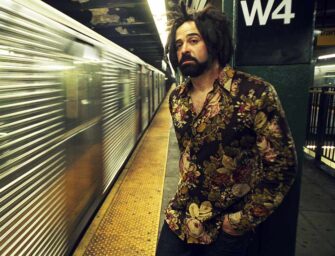Tunng’s Sam Genders takes us inside his new single and simultaneously provides a window into the world of AI-assisted songwriting
Both with his influential folktronica band Tunng and with his own project Diagrams, we’ve long been fans of the music made by Sam Genders. As a songwriter he’s constantly seeking inspiration from unusual places – whether in Einstein’s theory of general relativity or through working with nonagenarian poets (as on Diagrams’ 2017 album Dorothy).
His new single as Diagrams, Is This Real, continues this ingenious way of triggering ideas from unlikely sources or partnerships and takes it even further, this time through a collaboration with two deep-learning trained Artificial Intelligence systems (ALYSIA and MABEL) developed by American Scientist Dr Maya Ackerman. The song, all lo-fi twinkles and semi-robotic vocals, manages to be a gratifying listen while also provoking thoughts on the future possibilities of AI-assisted songwriting. Fascinated, we asked Sam to talk us through this unique creation…
Inspiration
I’ve enjoyed watching TED talks for the past seven or eight years and I’ve been fascinated by the rise of Artificial Intelligence (AI) described in some of their lectures. The speed of development is astonishing and it feels like we’re on the cusp of a very different world… assuming we, as a species, survive long enough to embrace that world. I like to think we will.
Growing up I loved sci-fi; films like Terminator and Alien and the books of Iain M. Banks, all of which describe worlds in which the lives of humans and intelligent machines are closely intertwined. They offered me a sense of escapism from a day-to-day life that I often found quite daunting and they lit up my imagination. I have a memory of being around eight years old, watching a Thunderbirds cartoon (the manga-inspired 80s remake, not the well-loved original). I felt a genuine sense of sadness and disappointment that I wouldn’t live to see a future of such technological wonders. Of course, now that world is rapidly coming to fruition.
I don’t know if that’s a good thing or not and of course the reality will likely be more complicated than that. At the moment people ask me if this technology may someday supersede the human songwriter and if so, isn’t that a bad thing?
I really don’t know, but I doubt that the next few decades will make me redundant because songwriting is more than just craft. There’s also the very personal story or ideas that the songwriter chooses to convey and the way the song is presented through performance, recording or visual media. There’s a huge amount of room for individual art and exploration.

Diagrams: I’m dipping the tip of my toe into this ocean of future possibilities. Photo: Paul Heartfield/Chrissie Abbott
Some people called Dylan ‘Judas’ and swore that electric guitars would ruin folk music, but what actually happened was a vast expansion of creative possibilities. The same happened as synthesizers emerged and opened up a whole new galaxy of experimental avenues. I suppose what I’m suggesting is that we don’t really know what the outcome of the development of AI will be, but as it’s happening in the world around me I’m intrigued to interact with it and explore some of its possibilities.
Imagine a near future when you could use a descendant of Elon Musk’s Neuralink system to connect your brain directly to the internet and use AI to incorporate the musical knowledge of history’s greatest artists and composers into your own creative flow. It could be an incredible experience. What would a song drawing on the total combined output of The Beatles, Mozart and Billie Eilish sound like? Well, yes, possibly awful… but also potentially amazing.
Looking further ahead, and assuming the continuation of our technological civilisation, I think there may come a time when an enhanced human of the far future will find the whole debate around human vs AI difficult to grasp. The two will have merged to such an extent that there will no longer be a clear division between them. Given enough time, these ideas don’t seem too far-fetched to me.
By collaborating with ALYSIA and MABEL I’m dipping the tip of my toe into this ocean of future possibilities. All of these thoughts grew into the concept behind Is This Real, which is about an AI consciousness awaking within a digital substrate and gradually becoming aware of itself. If consciousness is created within the brain, as most scientists believe, then why couldn’t it be created within an artificial lifeform? How would it feel as that first glimmer of awareness ignites?
Lyrics
“The gentle click of morning, the hum of sunlight, washes over me in binary.” These are the opening lines and I was trying to imagine how a morning sunrise might feel to such a digital being shortly after it was switched on for the first time. The first two verses continue in this vein and I wrote these along with the short repeated refrain of Is This Real before feeding them to ALYSIA who suggested melodies for each line.
After the second refrain (the closest the song comes to having a chorus) there’s a kind of extended middle section beginning with the following stanza:
A brown bird sits upon a garden fence,
Something is out of focus,
The cat is lying on the yellow chair,
She is happy like the sun.
These were inspired by an old TED talk about how scientists were trying to teach AI systems to recognise everyday objects. This seemingly simple task had turned out to be herculean in nature, but after many years they were finally cracking it. They could show the computer an image and it would describe what it saw… “A brown bird sits upon a garden fence…”
I then fed these four lines to MABEL who came up with reams of lyric options for me to choose from for the following two stanzas, before I then returned to a repeat of the “brown bird” lines for the fourth round.

Diagrams: ALYSIA’s melodies didn’t fit my musical plan at all, so I abandoned it. Photo: Paul Heartfield/Chrissie Abbott
This was an interesting process because when I first interacted with MABEL the lyrics she wrote were fairly poor. Basic nursery rhyme/pop song tropes, along the lines of, “I am right or wrong, I don’t need to be strong.”
I didn’t feel I could use them. However, the project was happening piece by piece around other work and progressed quite slowly. A few months later ALYSIA and MABEL’s creator Dr Maya Ackerman got in touch to say her team had been working on MABEL’s abilities and would I like to take another shot?
This time around, things were much more interesting. Whatever the AI equivalent of a psychedelic 60s awakening is, MABEL had had it. The lyrics she sent back in response to the same “brown bird…” lines were often wonderfully weird and unexpected. Out of a hundred or so lines of lyrics ranging from mundane, through beautiful to frankly bizarre, I chose the following eight lines and put them together to create the two required stanzas:
And he waits for the sun to come to blows
His hair is laughing at the lark
The grey is kicking in and out of his hair
As long as it feels like the sun
Where a calico wind is never lost
In a lonely church of broken mirrors
It’s just a secret you obey to betray
You wake up in a cold sweat.
Finally, after the repetition of the brown bird stanza I returned to my opening lines. “The gentle click of morning, the hum of sunlight, washes over me in binary.”
Music
As mentioned above, I started by writing lyrics for two verses and the Is This Real refrain. I fed these into ALYSIA and she composed melodies to match the syllables of my words. I’d started out the process with the framework for a song in my head, much as I would before going into a co-writing session. I like to have something strong prepared ahead of time which we can build on and into which I can incorporate the ideas of my co-writer. It’s my way of trying to hit the ground running.
However, just as is often the case with a human co-writer, ALYSIA wasn’t playing ball. Sometimes people just aren’t interested in working on an idea that they haven’t originated with you and they prefer to start something fresh. Luckily, I also love this way of working and it often leads to great results.
ALYSIA’s melodies didn’t fit my musical plan at all, so I abandoned it and just chose my favourite melodies from the ones she suggested. This was the point at which I really began to feel like I was collaborating with her. I was working with an early melodies-only-version of ALYSIA, so my next step was to take her melodies and write a chord pattern to support those melodies. This is unusual for me, as I tend to write chords first.

Sam Genders: This has been a genuinely fascinating songwriting experience. Photo: Paul Heartfield/Chrissie Abbott
I was writing on an acoustic guitar and from that point on I wrote very much as I would when writing by myself, honing the arrangement down and experimenting with different chords, whilst being careful not to alter ALYSIA’s melodies.
The final step was inserting MABEL’s lyrics and beginning to consider the production and instrumentation I would use when recording the track.
In The Studio
I was keen to embrace the initial sci-fi inspiration behind the track and for most of the track to be electronic, so I contacted Sheffield producer Martin Gregory Smith. Martin has worked with Richard Hawley and countless other artists in the classic producer role of recording a readymade ensemble to a high standard and then using tech to make everything sound extra special, but he’s also a highly respected film and TV composer and I knew he had the ability to create an electronic world for the song that would echo those classic 80s sci-fi soundtracks.
We spent a day or two laying down vocals and playing around with synth and drum machine parts until we had a sound that roughly approximates the final track. Martin then spent a couple more days tweaking everything and building an impressive, subtle soundscape that gradually builds into the final crescendo and incorporates a string arrangement by Danyal Dhondy. I envisaged Martin’s electronic world as the complex workings of the machine and Danyal’s beautiful viola playing as the spark of consciousness within.
Finally, Martin created a few mixes and I chose one that was at the slightly more lo-fi end of the spectrum, as I wanted to maintain that slight lack of gloss that those great old soundtracks had.
Final Thoughts
This has been a genuinely fascinating songwriting experience that has felt at times like a science research project. At other moments it’s been just like writing a song with a slightly uncooperative young writer. As this technology develops, people are undoubtedly going to begin using it more and more.
What that might mean for songwriters like me who manage to make a modest living from their own album projects, co-writing and some teaching is uncertain. Ten years ago some people found it hard to believe that AI translation tools could ever supplant human beings. Now, that future seems tantalisingly or worryingly close.
One thing I feel certain of is that the creative possibilities are endless and we probably can’t even imagine the scope of the journey our culture is embarking on. If the human race survives this technological upheaval… we’ve got some adventures in store.
Is This Real is out today. For further news and info, head over to diagramsmusic.com


































Related Articles